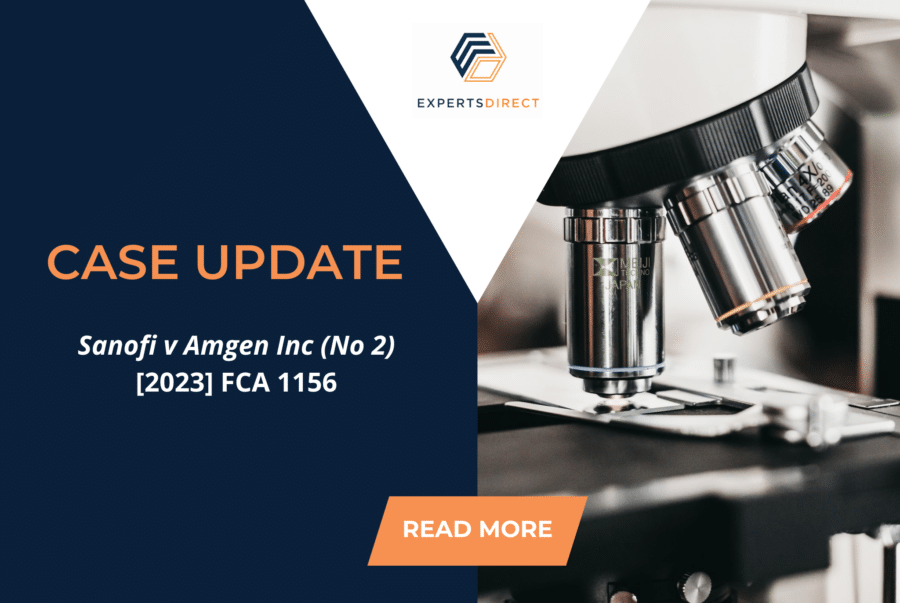Sanofi v Amgen Inc (No 2) [2023] FCA 1156
Sanofi appealed a decision of a delegate of the Commissioner of Patents in respect of proceedings commenced by it opposing a series of patent applications filed by Amgen Inc. In the appeal proceedings, Sanofi made an interlocutory application to limit the expert evidence to be adduced by Amgen Inc for the purposes of the appeal.
Background
Sanofi made an interlocutory application seeking orders pursuant to r 5.04 of the Federal Court Rules 2011 (Cth) limiting the evidence which Amgen could adduce in the appeal, being a hearing de novo in which Sanofi bears the onus of making out its grounds of opposition.
Expert evidence
The patent applications disclosed specialised techniques for the production of antibodies and assays, and techniques for the characterisation of protein interactions.
In support of the applications and the oppositions, both parties had relied on declarations made by numerous experts.
Sanofi raised several concerns about the evidence Amgen intended to adduce in the appeal. Sanofi advised Amgen that it was of the view that the evidence to be adduced by Amgen “should be confined to that of experts whose evidence does not duplicate that of your client’s other experts” (being those relied on for the purposes of the patent applications). In response, Amgen proposed that it would not read certain parts of the declaration and affidavit of one of their experts, Prof L, in respect of certain experiments relevant to the patent applications.
As a result of Amgen’s response, Sanofi filed an interlocutory application contending that the affidavits of all of Amgen’s experts – Prof GP, Prof L, and Prof H – were wholly unsatisfactory because they were:
- “substantially duplicative”; and
- both embarrassing and failed to comply with earlier orders made by the court.
Specifically, Sanofi contended that there was no substantial difference in the evidence given by Prof H compared to the evidence given by Prof GP and Prof L. Although Prof H had particular expertise in phage display technology, Sanofi asserted that this expertise was “largely irrelevant” and that Prof H’s evidence on this topic was “minimal”. Sanofi also contended that, in some respects, the evidence of Prof H and Prof L was substantially duplicative of the evidence of Prof GP.
Sanofi also complained that Prof GP, Prof L, and Prof H had adopted the technique of “summarising” statements made in their declarations, which had the effect of duplicating or recasting their evidence, leaving it uncertain as to whether the summaries stood as the evidence of the experts. Sanofi argued that this was embarrassing because it did not know which part of Amgen’s evidence it was required to respond to.
Further, Sanofi was concerned that permitting Amgen to rely on all of this evidence would have the effect of affording Amgen a superior advantage in terms of the number of expert witnesses who would participate in expert conclaves and in giving concurrent evidence. Sanofi submitted that this raised serious questions to the fair, efficient, and effective conduct of the appeal.
The court was not persuaded. Yates J held that, whilst economy in the number of experts is always desirable, his Honour perceived no problem in the experts participating in conclaves and discussing their views on the matters on which they have been asked to opine, with a view to preparing a joint report identifying and explaining their areas of agreement and disagreement. [32]
Similarly, Yates J perceived no problem in the experts giving concurrent evidence, because it is wrong to think that questions of fact based on expert evidence are determined on a “majority” view. [33]
The court ruled that scope always exists for differences in language to emerge between what was said in a declaration and what was said in an affidavit. Some “summarising” would inevitably be involved, as well as some duplication. [39]
The court also held that Sanofi had amply demonstrated that it could identify the existence of possible differences between what a witness had said in a declaration and what the same witness had said in their affidavit. Sanofi would be able to raise with its own expert witnesses whether there was, in substance, a “disconformity” and, if so, whether that matter was worthy of being addressed by responding evidence. “Disconformities” were also capable of being addressed by the experts themselves in a conclave. [40]
The interlocutory application was dismissed.
Key takeaways
- Appeals from a decision of a delegate of the Commissioner of Patents in patent opposition proceedings may lead to duplicative expert evidence being adduced for the purposes of the hearing de novo by the Federal Court.
- Notwithstanding that economy in the number of experts involved in proceedings is preferrable, the involvement of numerous experts may not necessarily lead to the other side suffering any actual or potential prejudice.
- Any differences in what is said by expert witnesses in declarations for the purposes of patent opposition proceedings, and any subsequent affidavits in the appeal is a matter than can be identified and assessed whether it needs to be addressed by subsequent responding evidence.
Read the full decision here.
